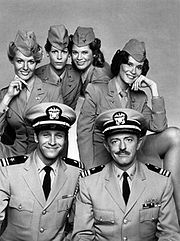
The United States Pacific Fleet (USPACFLT) is a theater-level component command of the United States Navy, located in the Pacific Ocean. It provides naval forces to the Indo-Pacific Command. Fleet headquarters is at Joint Base Pearl Harbor–Hickam, Hawaii, with large secondary facilities at Naval Air Station North Island, California.
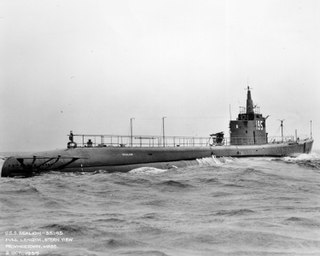
USS Sealion (SS-195), a Sargo-class submarine, was the first ship of the United States Navy to be named for the sea lion, any of several large, eared seals native to the Pacific.

The submarine film is a subgenre of war film in which the majority of the plot revolves around a submarine below the ocean's surface. Films of this subgenre typically focus on a small but determined crew of submariners battling against enemy submarines or submarine-hunter ships, or against other problems ranging from disputes amongst the crew, threats of mutiny, life-threatening mechanical breakdowns, or the daily difficulties of living on a submarine.

USS Jonas Ingram (DD-938), named for Admiral Jonas H. Ingram USN (1886–1952), awarded the Medal of Honor when a Lieutenant for his actions during the engagement of Vera Cruz on 22 April 1914, was a Forrest Sherman-class destroyer laid down by the Bethlehem Steel Corporation at Quincy in Massachusetts on 15 June 1955, launched on 7 August 1956 by Mrs. Lawrence Hays, Jr., daughter of Admiral Ingram and commissioned on 19 July 1957 at Boston Naval Shipyard. USS Jonas Ingram was decommissioned on 4 March 1983, stricken from the Naval Vessel Register on 15 June 1983 and sunk as a target on 23 July 1988.

Down Periscope is a 1996 American military comedy submarine film directed by David S. Ward, produced by Robert Lawrence, and starring Kelsey Grammer, Lauren Holly, and Rob Schneider along with Bruce Dern, Harry Dean Stanton, William H. Macy, and Rip Torn in supporting roles. Released by 20th Century Fox on March 1, 1996, the film focuses on Lieutenant Commander Thomas Dodge, a capable U.S. Navy officer who fights to save his career after being saddled with a group of misfit seamen who have been brought together as the crew of his first command, USS Stingray, a rusty, obsolete World War II-era diesel submarine that is the focus of a special naval war game, supervised by a bitter rival who is fighting to bury Dodge's career by any means necessary.

USS Razorback (SS-394), a Balao-class submarine, was the only ship of the United States Navy to be named after the razorback, a species of whale found in the far southern reaches of the Pacific Ocean. She is arguably the longest-serving combat front-line submarine still existing in the world, having been commissioned by two different countries for 56 years of active duty. She was in Tokyo Bay during the surrender of Japan. In 2004, the state of Arkansas adopted the submarine and she is now a museum ship at the Arkansas Inland Maritime Museum.
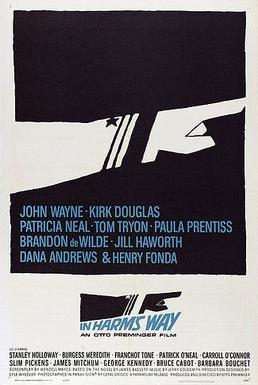
In Harm's Way is a 1965 American epic historical romantic war film produced and directed by Otto Preminger and starring John Wayne, Kirk Douglas, and Patricia Neal, with a supporting cast featuring Henry Fonda in a lengthy cameo, Tom Tryon, Paula Prentiss, Stanley Holloway, Burgess Meredith, Brandon deWilde, Jill Haworth, Dana Andrews, and Franchot Tone. Produced with Panavision motion picture equipment, it was one of the last black-and-white World War II epics, and Wayne's last black-and-white film. The screenplay was written by Wendell Mayes, based on the 1962 novel Harm's Way, by James Bassett.

USS Skipjack (SS-184), was a Salmon-class submarine, the second ship of the United States Navy to be named after the skipjack tuna. She earned multiple battle stars during World War II and then was sunk, remarkably, by an atomic bomb during post-World War II testing in Operation Crossroads. Among the most "thoroughly sunk" ships, she was refloated and then sunk a second time as a target ship two years later.

Destination Tokyo is a 1943 black and white American submarine war film. The film was directed by Delmer Daves in his directorial debut, and the screenplay was written by Daves and Albert Maltz, based on an original story by former submariner Steve Fisher. The film stars Cary Grant and John Garfield and features Dane Clark, Robert Hutton, and Warner Anderson, along with John Ridgely, Alan Hale Sr. and William Prince.

USS Balao (SS/AGSS-285) was the lead ship of the United States Navy's Balao-class submarines during World War II and named for the balao, a small schooling marine fish.
The names of commissioned ships of the United States Navy all start with USS, for United States Ship. Non-commissioned, primarily civilian-crewed vessels of the U.S. Navy under the Military Sealift Command have names that begin with USNS, standing for United States Naval Ship. A letter-based hull classification symbol is used to designate a vessel's type. The names of ships are selected by the Secretary of the Navy. The names are those of states, cities, towns, important persons, important locations, famous battles, fish, and ideals. Usually, different types of ships have names originated from different types of sources.

Lawson Paterson "Red" Ramage was a vice admiral in the United States Navy and a noted submarine commander during World War II. Ramage was decorated with the Medal of Honor and several other combat decorations during the war. He also served during the Korean War and the Vietnam War.

USS Conner (DD-582) was a Fletcher-class destroyer of the United States Navy, the second Navy ship to be named in honor of Commodore David Conner (1792–1856), who led U.S. Naval forces during the first part of the Mexican–American War.
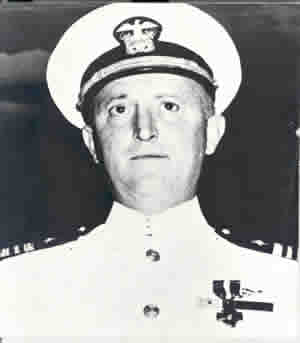
Howard Walter Gilmore was a submarine commander in the United States Navy who posthumously received the Medal of Honor for his self-sacrifice during World War II.

Harm's Way is a 1962 war novel by James Bassett. Set in the Pacific theater during World War II, it follows the exploits of Captain Rockwell "Rock" Torrey as he plans and carries out naval operations against the Japanese. The book was adapted into the 1965 film In Harm's Way, which was produced and directed by Otto Preminger and starred John Wayne and Kirk Douglas.

Hell Below is a 1933 American MGM pre-Code film set in the Adriatic Sea during World War I about submarine warfare based on Commander Edward Ellsberg's novel Pigboats. The film stars Robert Montgomery, Walter Huston, Robert Young, Madge Evans and Jimmy Durante.

Submarine Command is a 1951 American war film directed by John Farrow and starring William Holden, Don Taylor, Nancy Olson, William Bendix, and Darryl Hickman. It is notable for being one of the first films to touch on post traumatic stress disorder. Holden invested $20,000 of his own money into the film. The film received a mixed reception: it was panned by some critics for its brooding melodrama whilst being praised by others.

Operation Petticoat is an American sitcom that was based on the 1959 film by the same name. It was broadcast on ABC for two seasons, from September 17, 1977, until October 16, 1978.

Commander James Wiggins "Red" Coe (missing), January 8, 1946 was an American submariner. A submarine ace, Coe commanded USS Skipjack and Cisco during operations in the Pacific theatre of World War II. After a number of successful patrols, Coe and the Cisco failed to return from patrol in November 1943, and her captain and crew were presumed dead in 1946.
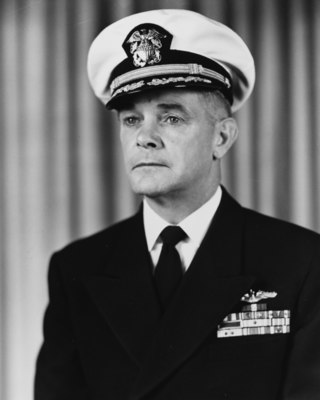
James Charles Dempsey, was a decorated submarine commander during World War II who reached the rank of Rear Admiral in the United States Navy. He died, aged 70, on July 9, 1979, of congestive heart and kidney failure at the Portsmouth Naval Hospital in Norfolk, Virginia.


